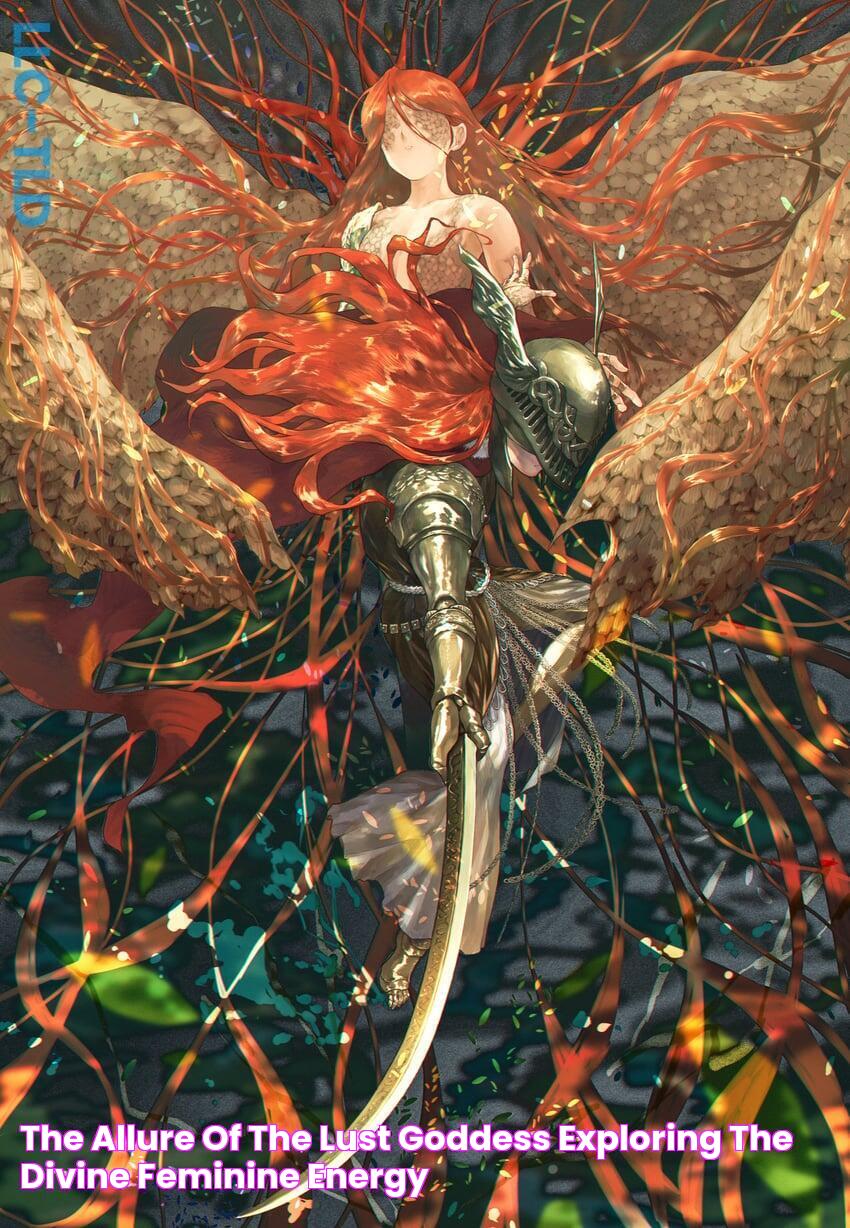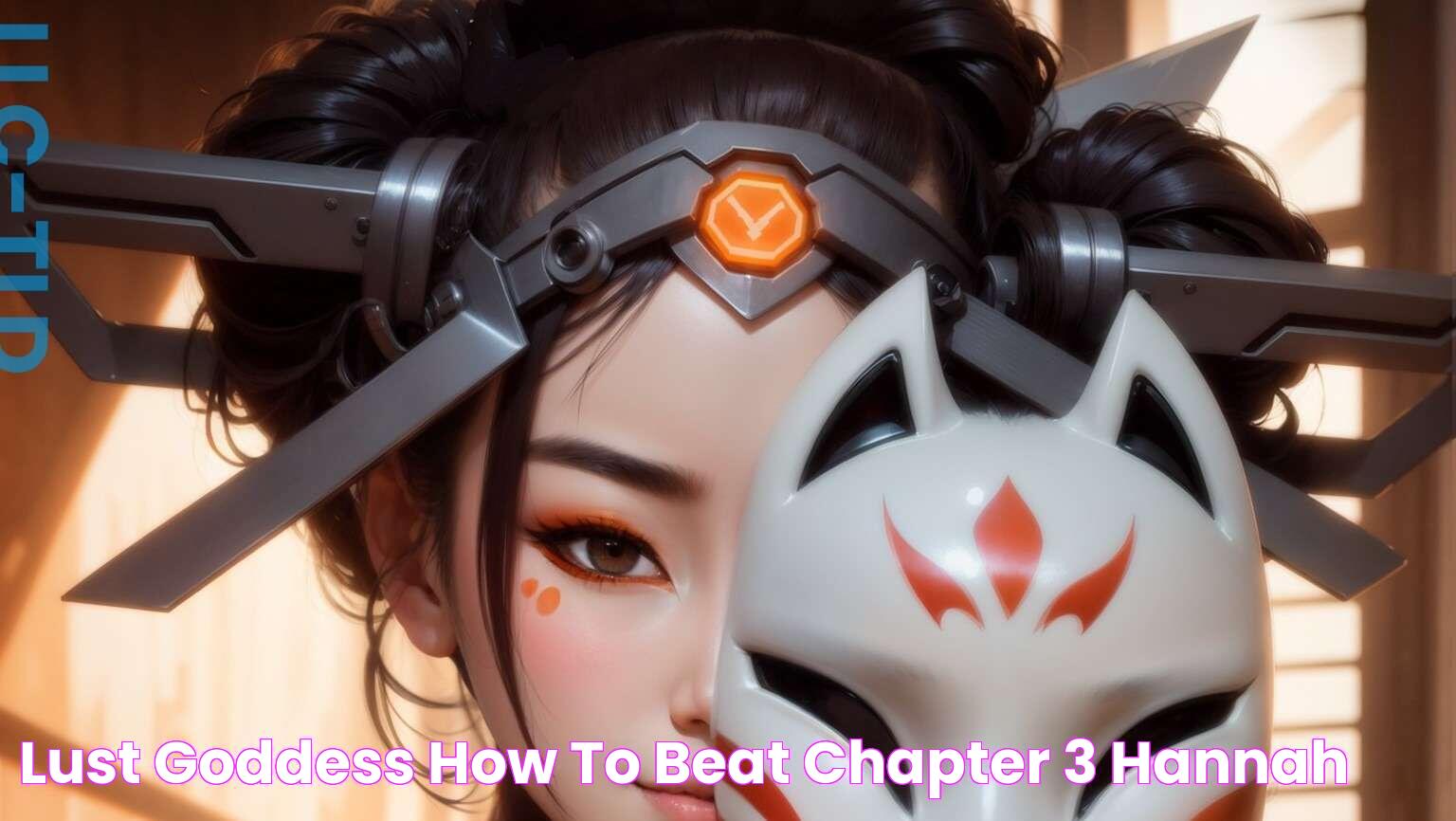Guide To Invoke The Alluring Lust Goddess
The term "lust-goddess" refers to a female deity or supernatural being associated with carnal desire, sexual passion, and erotic love. Throughout history and across various cultures, lust-goddesses have been worshipped and revered for their embodiment of these primal instincts.
These deities often played significant roles in religious rituals, fertility rites, and the exploration of human sexuality. Their importance stems from the recognition of the powerful and transformative nature of lust and desire. By honoring and connecting with lust-goddesses, individuals and communities sought to harness and channel these energies for personal empowerment, spiritual growth, and the celebration of life's sensual pleasures.
In contemporary contexts, the concept of the lust-goddess continues to resonate, inspiring artistic expression, literary exploration, and personal reflection on the nature of desire. Through the exploration of these divine feminine archetypes, we gain insights into our own sexuality, relationships, and the pursuit of pleasure and fulfillment.
Read also:69 Kilogram To Pounds Easily Convert With Precision
Lust-Goddess
The term "lust-goddess" encompasses various aspects related to the divine feminine and the embodiment of carnal desire, sexual passion, and erotic love. Here are six key aspects that explore the essence of this concept:
- Sensuality: Embodiment of physical pleasure and erotic desire.
- Fertility: Association with procreation, abundance, and the life force.
- Empowerment: Representation of female power, agency, and sexual liberation.
- Ritual: Central figures in religious practices and fertility rites.
- Mythology: Featured in myths and legends across cultures, often as archetypes of desire.
- Art: Inspiration for artistic expression, symbolizing beauty, sensuality, and the erotic.
These aspects intertwine to form a complex and multifaceted understanding of the lust-goddess archetype. They represent the recognition and celebration of female sexuality, the power of desire, and the connection between the physical and spiritual realms. By exploring these dimensions, we gain insights into the nature of lust, passion, and the enduring allure of the lust-goddess figure throughout history and cultures.
1. Sensuality
Sensuality forms the very essence of the lust-goddess archetype. These deities embody the raw, untamed power of physical pleasure and erotic desire. They represent the celebration of the senses and the exploration of the body's capacities for sensual enjoyment. Through their stories and iconography, lust-goddesses encourage individuals to embrace their sensuality, to revel in the beauty of their physical forms, and to experience the full spectrum of erotic delights.
This connection between sensuality and the lust-goddess is evident in various cultures and historical periods. In ancient Greece, for instance, Aphrodite, the goddess of love, beauty, and pleasure, was worshipped as the epitome of female sensuality. Her image adorned temples and sculptures, embodying the ideal of physical perfection and erotic allure. Similarly, in Hindu mythology, the goddess Kali represents both the destructive and creative forces of the universe. She is often depicted as a voluptuous figure, adorned with skulls and severed heads, symbolizing her power to embrace both life and death, pleasure and pain.
Understanding the connection between sensuality and the lust-goddess is crucial for appreciating the multifaceted nature of these divine feminine archetypes. They remind us that sensuality is a vital aspect of human experience, one that should be celebrated and honored. By embracing the lust-goddess within, individuals can unlock their own sensual potential, enhance their relationships, and experience a deeper sense of self-love and acceptance.
2. Fertility
The connection between fertility and lust-goddesses is deeply rooted in the human experience. Throughout history, women have been revered for their ability to give birth and sustain life, and this power has been embodied in the concept of the lust-goddess. These deities represent the creative and nurturing aspects of the divine feminine, symbolizing abundance, procreation, and the life force itself.
Read also:The Ultimate Guide To Apponfly A Powerful App Testing Tool
In ancient Egypt, Isis was worshipped as the goddess of fertility, motherhood, and magic. She was often depicted with a headdress adorned with the horns of a cow, representing her association with fertility and abundance. Similarly, in Norse mythology, Freya was the goddess of love, beauty, and fertility. She was believed to control the fertility of both humans and animals, and her favor was sought by those seeking to conceive or ensure a bountiful harvest.
Understanding the connection between fertility and lust-goddesses provides insights into the importance of procreation and the life force in human societies. These deities represent the power of women to create and sustain life, and their worship reflects the deep reverence for the feminine principle in many cultures.In contemporary times, the concept of the lust-goddess continues to resonate, particularly in feminist and neo-pagan movements. By reclaiming and celebrating the archetype of the lust-goddess, individuals seek to empower themselves and embrace their own creative and life-giving potential. This connection between fertility and the lust-goddess reminds us of the importance of honoring the feminine principle, cherishing our bodies, and recognizing the interconnectedness of all living beings.
3. Empowerment
Within the concept of the lust-goddess, empowerment emerges as a central aspect, representing the divine feminine's power, agency, and sexual liberation. This empowerment manifests in various ways, influencing both individuals and societies.
Historically, lust-goddesses have challenged patriarchal norms and subverted traditional gender roles. By embodying female desire and sexuality, they empowered women to reclaim their bodies, assert their autonomy, and pursue pleasure on their own terms. In ancient Greece, for instance, the cult of Aphrodite fostered a culture of female empowerment and sexual freedom, particularly among women known as hetaerae, who were celebrated for their intelligence, wit, and independence. Similarly, in India, the goddess Kali symbolizes the fierce and untamed aspects of the feminine, representing women's strength, resilience, and ability to overcome adversity.
In contemporary contexts, the concept of the lust-goddess continues to inspire movements for female empowerment and sexual liberation. By embracing the lust-goddess archetype, individuals and communities seek to break free from societal constraints, challenge restrictive beauty standards, and promote body positivity. This empowerment extends beyond the personal realm, as it contributes to broader cultural shifts towards gender equality and the dismantling of patriarchal structures.
Understanding the connection between empowerment and the lust-goddess provides valuable insights into the ongoing struggle for female liberation and the recognition of women's rights. By exploring this archetype, we gain a deeper appreciation for the power, agency, and resilience of women, both historically and in the present day.
4. Ritual
Within the realm of the lust-goddess, rituals play a pivotal role, serving as central elements in religious practices and fertility rites across cultures and historical periods. These rituals embody the deep connection between the divine feminine, sexuality, and the sacred.
- Sacred Sexuality:
Lust-goddesses are often central figures in rituals sacred sexuality, where sexual acts are imbued with spiritual significance. These rituals may involve sacred prostitution, as in the case of the ancient Mesopotamian goddess Inanna, orTantric practices aimed at spiritual enlightenment and transcendence.
- Fertility Rites:
Lust-goddesses are frequently invoked in fertility rites, where they are implored to bless crops, livestock, and human reproduction. These rituals may include processions, offerings, and symbolic acts designed to promote abundance and ensure the continuation of life.
- Initiation and Transformation:
Rituals centered around lust-goddesses often serve as rites of passage or initiation, particularly for young women transitioning into adulthood or new roles within their communities. These rituals may involve symbolic acts of defloration or purification, marking the passage from one stage of life to another.
- Devotion and Worship:
Lust-goddesses are the focus of devotional practices and religious cults, where individuals gather to honor, worship, and seek blessings from these deities. These rituals may involve prayers, offerings, and the performance of specific rituals designed to connect with the divine feminine.
The connection between rituals and lust-goddesses underscores the sacred and profound nature of sexuality and fertility. These rituals provide a structured and communal context for individuals to explore their sexuality, connect with the divine, and seek blessings for abundance and prosperity. Understanding this connection deepens our appreciation for the multifaceted role of lust-goddesses in human cultures and spirituality.
5. Mythology
The connection between mythology and lust-goddesses is deeply intertwined, with lust-goddesses frequently featuring in myths and legends across cultures as archetypes of desire. These archetypal representations embody the raw, untamed aspects of human sexuality and passion, serving as powerful symbols and sources of inspiration.
Mythology provides a rich tapestry for exploring the complexities of desire, delving into the motivations, consequences, and transformative power of lust. Through the stories and characters associated with lust-goddesses, individuals can gain insights into their own desires, grapple with moral dilemmas, and explore the boundaries of sexual expression.
For instance, the Greek myth of Aphrodite, the goddess of love and beauty, illustrates the irresistible and often chaotic nature of desire. Aphrodite's birth from sea foam symbolizes the unpredictable and primal origins of desire, while her relationships with gods and mortals highlight the complexities of love, jealousy, and the pursuit of pleasure. Similarly, the Hindu goddess Kali represents the untamed and destructive aspects of desire, reminding us of the potential for passion to lead to both creation and destruction.
Understanding the connection between mythology and lust-goddesses enhances our appreciation for the cultural and historical significance of these archetypes. By examining the myths and legends surrounding lust-goddesses, we gain insights into the human experience of desire and its enduring power to shape our lives and societies.6. Art
The connection between art and lust-goddesses is undeniable, as art serves as a powerful medium for expressing and exploring the beauty, sensuality, and eroticism associated with these divine feminine archetypes. Throughout history and across cultures, artists have drawn inspiration from lust-goddesses to create captivating works that celebrate the female form, explore the nature of desire, and push the boundaries of artistic expression.
The allure of lust-goddesses lies in their embodiment of raw, untamed sexuality, making them a potent source of inspiration for artists seeking to capture the essence of eroticism and sensuality. From the voluptuous curves of Aphrodite in classical Greek sculpture to the seductive poses of Hindu goddesses in temple carvings, artists have used their skills to immortalize the beauty and power of these divine beings. By depicting lust-goddesses in various forms and contexts, art transcends cultural and temporal boundaries, allowing us to appreciate the enduring fascination with the feminine and the erotic.
Furthermore, art plays a significant role in shaping our understanding and perception of lust-goddesses. Through paintings, sculptures, and other art forms, artists interpret and communicate the symbolic meanings associated with these deities. For instance, the depiction of Aphrodite as a goddess of love and procreation highlights her role in ensuring the continuation of life, while the fierce and untamed nature of Kali reflects her association with destruction and transformation. By presenting diverse representations of lust-goddesses, art contributes to the cultural and mythological narratives surrounding these divine figures.
In contemporary art, the connection between lust-goddesses and artistic expression remains strong. Many contemporary artists continue to find inspiration in these archetypes, using their work to challenge societal norms, explore gender and sexuality, and celebrate the power of the feminine. Through installations, performance art, and digital media, artists engage with the concept of the lust-goddess in new and thought-provoking ways, inviting us to reconsider our own perceptions and prejudices.
In conclusion, the connection between art and lust-goddesses is multifaceted and enduring. Art serves as a platform for expressing the beauty, sensuality, and eroticism associated with these divine feminine archetypes, while also shaping our understanding and perception of them. By exploring the relationship between art and lust-goddesses, we gain insights into the power of artistic expression, the enduring fascination with the feminine, and the ongoing dialogue surrounding gender, sexuality, and desire.
Frequently Asked Questions on Lust-Goddesses
The concept of the lust-goddess has been a subject of fascination and inquiry throughout history. To shed light on common concerns and misconceptions, here are a few frequently asked questions and their corresponding answers:
Question 1: What is the significance of lust-goddesses in different cultures?
Answer: Lust-goddesses have played significant roles in various cultures, embodying aspects such as fertility, sensuality, and female empowerment. They represent the acknowledgment and celebration of human sexuality and desire, and their worship or veneration has been a means of connecting with these energies.
Question 2: How have lust-goddesses been portrayed in art and mythology?
Answer: Lust-goddesses have served as a source of inspiration for artistic expression across cultures and historical periods. In art, they are often depicted as symbols of beauty, sensuality, and eroticism, while in mythology, they are featured in narratives that explore themes of desire, love, and procreation.
Question 3: What is the relationship between lust-goddesses and female empowerment?
Answer: Lust-goddesses have been associated with female empowerment in various ways. By embodying female sexuality and desire, they challenge traditional gender roles and patriarchal norms. They represent the idea that women have agency over their bodies and sexuality, and their worship or celebration can be seen as a form of resistance against societal constraints.
Question 4: How do lust-goddesses connect to fertility and abundance?
Answer: Many lust-goddesses are associated with fertility and abundance. They represent the life-giving and nurturing aspects of the divine feminine, and their worship or invocation is often linked to rituals and practices aimed at promoting fertility, both in terms of procreation and agricultural abundance.
Question 5: What is the role of rituals in the worship of lust-goddesses?
Answer: Rituals have played a significant role in the worship of lust-goddesses across cultures. These rituals can involve offerings, prayers, and symbolic acts designed to honor the deity and seek blessings or favor. They provide a structured and communal context for devotees to connect with the divine feminine and express their devotion.
Question 6: How can we understand the enduring fascination with lust-goddesses?
Answer: The enduring fascination with lust-goddesses stems from their embodiment of primal desires and instincts. They represent the raw and untamed aspects of human sexuality and sensuality, which continue to captivate and intrigue people across cultures and generations. Their enduring presence in art, mythology, and religious traditions reflects the human preoccupation with themes of love, desire, and the exploration of the erotic.
In conclusion, the concept of the lust-goddess is a multifaceted and cross-cultural phenomenon that has played a significant role in shaping human understanding of sexuality, desire, and the divine feminine. By exploring the various aspects of lust-goddesses, we gain insights into the complexities of human nature and the enduring power of these archetypal figures.
Transition to the next article section: While the concept of the lust-goddess has a long and rich history, it is important to acknowledge that interpretations and perspectives on these deities may vary across cultures and individuals. As we delve deeper into the topic, we will explore diverse viewpoints and engage with ongoing discussions surrounding the significance and relevance of lust-goddesses in contemporary society.
Tips for Understanding and Engaging with the Concept of the Lust-Goddess
Exploring the concept of the lust-goddess can be a multifaceted and enriching endeavor. Here are five tips to guide you in your exploration and understanding:
Tip 1: Acknowledge Cultural and Historical Context:
Recognize that the concept of the lust-goddess has been shaped by diverse cultures and historical periods. Each culture's interpretation and portrayal of these deities may vary, reflecting the specific beliefs, values, and social norms of the time.
Tip 2: Explore Archetypal Symbolism:
Lust-goddesses often embody archetypal symbols and themes related to sexuality, desire, fertility, and the divine feminine. Understanding these archetypal connections can provide deeper insights into the multifaceted nature of these deities and their significance across cultures.
Tip 3: Examine Artistic Representations:
Art, including paintings, sculptures, and literature, has played a crucial role in representing and interpreting lust-goddesses. By examining artistic depictions, you can gain insights into the cultural and historical perceptions of these deities and the ways in which they have been portrayed and celebrated.
Tip 4: Engage with Mythology and Folklore:
Mythology and folklore offer rich narratives and stories involving lust-goddesses. Exploring these tales can provide context and understanding of the roles, powers, and relationships associated with these deities within specific cultural frameworks.
Tip 5: Respect Diverse Perspectives:
Recognize that interpretations and perspectives on lust-goddesses may vary widely. Respect diverse viewpoints and engage in open-minded discussions to gain a comprehensive understanding of the multifaceted nature of these archetypes.
By following these tips, you can approach the concept of the lust-goddess with a deeper understanding and appreciation for its cultural, historical, and symbolic significance.
Summary of Key Takeaways:
- Consider the cultural and historical context of lust-goddesses.
- Explore the archetypal symbolism associated with these deities.
- Examine artistic representations to gain insights into cultural perceptions.
- Engage with mythology and folklore to understand their roles and narratives.
- Respect diverse perspectives and engage in open-minded discussions.
These tips will enhance your understanding and appreciation of the complex and fascinating concept of the lust-goddess.
Conclusion
Our exploration of the concept of the lust-goddess has unveiled a multifaceted figure deeply entwined with human sexuality, desire, fertility, and the divine feminine. Across cultures and historical periods, these deities have embodied the untamed and often paradoxical nature of human passions.
The enduring fascination with lust-goddesses reflects our ongoing preoccupation with the enigmatic forces that shape our desires, relationships, and experiences of pleasure. By delving into the mythology, art, and rituals surrounding these archetypal figures, we gain insights into the complexities of our own sexuality and the enduring power of the divine feminine.
As we continue to engage with the concept of the lust-goddess, let us remember the importance of respecting diverse perspectives and interpretations. By embracing open-minded inquiry and fostering respectful dialogue, we can deepen our understanding of these enigmatic and captivating deities and their enduring significance in human culture.
How Old Is Larsa Pippen? | Current Age And Year Of Birth
Uncover Your Destiny: The Zodiac Sign For September 6th
Must-See 9vidd Discoveries That Will Amaze You


